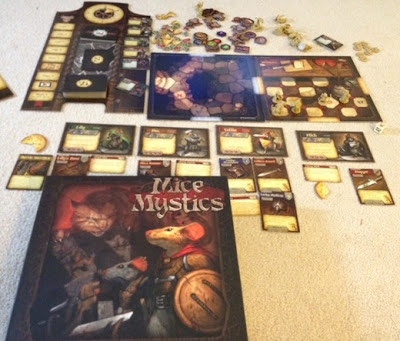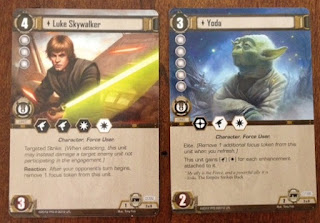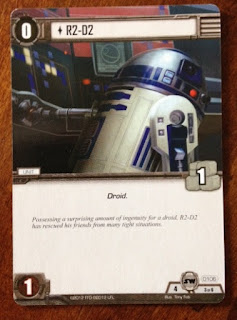A light little filler game that I tried recently was Monopoly Deal.
Don't let the name fool you - Monopoly Deal is about as much like normal Monopoly as having a tooth extracted (without even having anesthetic) is "major surgery". Here's how it works - each player starts the game with some cards. Each turn, you draw two cards, play up to three cards, and then discard to seven cards in your hand (rarely an issue). The object of the game is to get three complete property sets. Cards come in three main varieties: Money (ranging from $1 Million to $10 Million), Actions (that kick your friends in the teeth and steal from them while they're down), and Properties (that you then have stolen from you while you're on the ground after being kicked). The properties will be the old staples that you're used to, but there are also Wild properties that help you to more easily complete sets. Money is simply money - it's used to pay for things (and serves as a buffer before you have to pay in property). Actions range from forcing players to give you $2 Million as a birthday gift to stealing a complete property set, charging rent to drawing extra cards. Oh, and every action card has a monetary value and can be played as "Money" instead of as an action. Once someone gets their three complete property sets, they are the winner.
The first thing that I like about Monopoly Deal is that it is a fast paced game. Now, don't get me wrong - I actually enjoy the original game of Monopoly. However, it's not for everyone, and I understand that. Monopoly Deal can be played in a fraction of the time of normal Monopoly. Theoretically, the entire game can be over in two rounds! (If you are able to complete the three 2-property color sets (Mediterranean/Baltic, Boardwalk/Park Place, Electric Company/Water Works.) However, fortunately it's not normally that fast. Either way, turns go very quickly, so there does not feel like very much down time in the game.
 |
| Not quite as drooled over as before. |
The next thing that I like about the game is that you're never completely out of contention. Yes, if you have no property in front of you, the game can be much more challenging, but there are combinations of cards that can immediately get you right back into contention. If, for example, you had no properties and one of your opponent's had Boardwalk & Park Place, you could use "Deal Breaker" to steal their set, and then play "Double the Rent" with a Dark Blue "Rent" card to go from having nothing to having all of your opponents pay you $16 Million dollars, all on one turn! (Assuming that your opponent that you steal the property set from does not have a "Just Say No" card.) Think about normal Monopoly - when you're losing heavily, what are the chances of you winning? Approximately 0.0003%? That's not true with Monopoly Deal.
Third, I like that Monopoly Deal is a friendly back-stabby game. What I mean is that, yes, you are constantly stabbing the other players in the back. However, they probably won't grow too irritated because they are about to do the same thing. And, the backstabbing happens early enough and often enough in the game that it doesn't feel like you've worked towards something all game and then someone swooped in at the last second to mess up your whole plan. You get stabbed the whole time you try to execute your plan, and if your planning doesn't involve stealing things from your opponents, then it's destined for failure. Let me put it this way - you'll spend as much time looking at what your opponent's have in play (your "options") as you will what's in your hand.
Finally, Monopoly Deal is able to open doors with people who don't normally play many games. Ever had this conversation, "I like board games." "Oh, you mean like Monopoly and Scrabble?" (Mine normally is "I write about board games." "Oh, you mean like Monopoly and Scrabble?" Sometimes they mix in Risk.) You can now answer, "Sure. You should try Monopoly Deal with us. You might like it." Monopoly Deal is fun - they probably will enjoy it. And then, *BAM*, spring Dominion on them the next day!! Or something like that...
 |
| Let's make a deal... |
The second thing that I think I will list as a con is that I'm not a huge fan of how Rent works. Especially with houses and hotels. To play a house or hotel, you have to have a complete property set - and then it simply increases the rent that can be charged. But, to charge rent, you have to draw the appropriate "Rent" card (each basic Rent card allows you to pick between two color sets and charge all other players Rent. There is also one or two "wild" Rent cards that allow you to charge one player Rent in any color.) Rent seems to require too much setup for too little payoff - especially with the crummier color sets. If I play "It's My Birthday!" then every other player owes me $2 Million. However, if I play Oriental Avenue and then charge Rent on it, I believe each other player owes me $1 Million - for a two card setup! It makes you wonder what's the point in them even including the Rent cards for some of these colors. Rent just feels a bit too castrated in this game.
The final thing that I will mention is that the instructions are not especially clear. Yes, the game is pretty simple, but when the instructions say something like "just start playing, and it'll make sense" (paraphrased), that's not really a good sign. I still don't know what happens in certain situations in the game - like if I have a house on a property set, and I have to break the set - what happens to the house? Or, if I have a wild property that is worth "no monetary value" and someone charges me more than I can pay, do I have to give them that card? That's like me being so broke that I pay someone all that I own and then give them the lint from my pocket or used candy wrappers and pretend that it increases the value.
Overall, I give Monopoly Deal a 8.0/10. It's a fun, light-weight filler game. And, you can probably pick it up for around $6 at most any big-box store. I would recommend you check it out.
If Monopoly Deal sounds fun, you might also check out Bang!, Hecho, and Jab: Real Time Boxing.






















